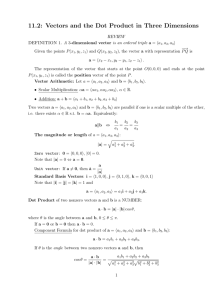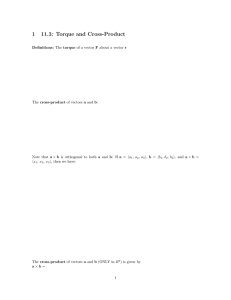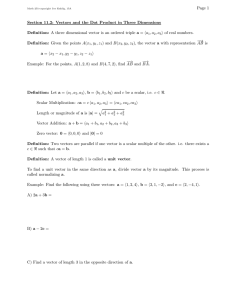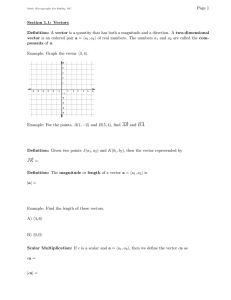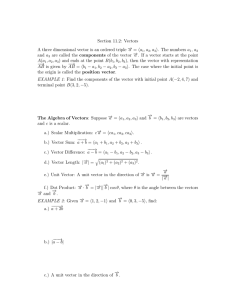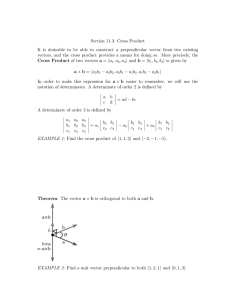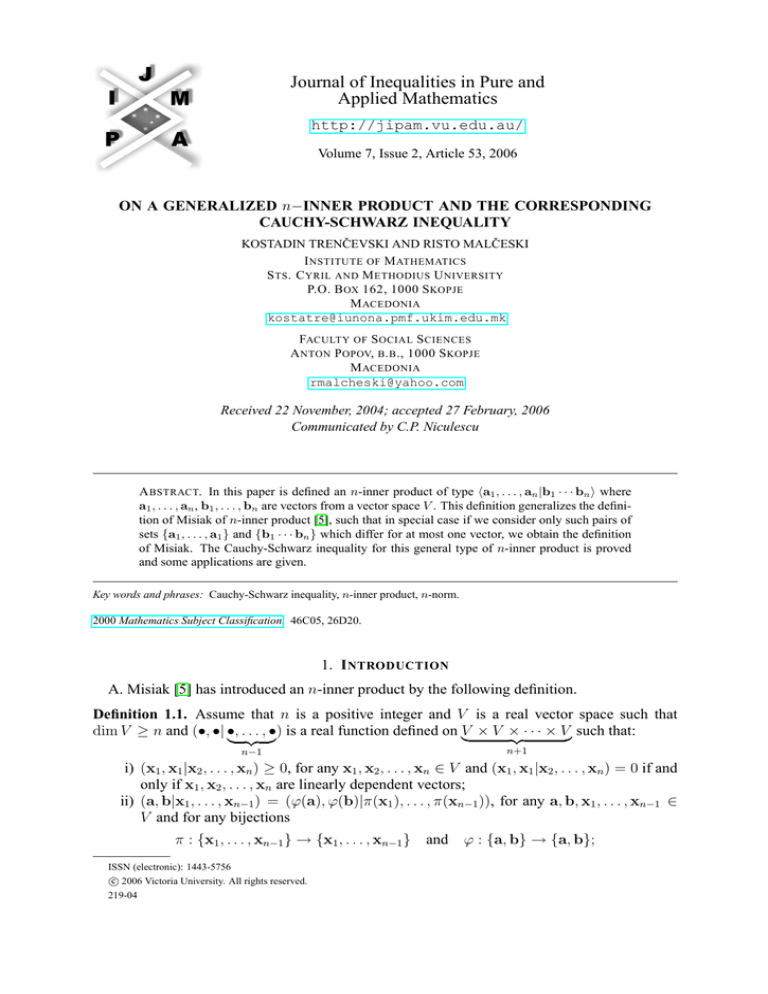
Journal of Inequalities in Pure and
Applied Mathematics
http://jipam.vu.edu.au/
Volume 7, Issue 2, Article 53, 2006
ON A GENERALIZED n−INNER PRODUCT AND THE CORRESPONDING
CAUCHY-SCHWARZ INEQUALITY
KOSTADIN TRENČEVSKI AND RISTO MALČESKI
I NSTITUTE OF M ATHEMATICS
S TS . C YRIL AND M ETHODIUS U NIVERSITY
P.O. B OX 162, 1000 S KOPJE
M ACEDONIA
kostatre@iunona.pmf.ukim.edu.mk
FACULTY OF S OCIAL S CIENCES
A NTON P OPOV, B . B ., 1000 S KOPJE
M ACEDONIA
rmalcheski@yahoo.com
Received 22 November, 2004; accepted 27 February, 2006
Communicated by C.P. Niculescu
A BSTRACT. In this paper is defined an n-inner product of type ha1 , . . . , an |b1 · · · bn i where
a1 , . . . , an , b1 , . . . , bn are vectors from a vector space V . This definition generalizes the definition of Misiak of n-inner product [5], such that in special case if we consider only such pairs of
sets {a1 , . . . , a1 } and {b1 · · · bn } which differ for at most one vector, we obtain the definition
of Misiak. The Cauchy-Schwarz inequality for this general type of n-inner product is proved
and some applications are given.
Key words and phrases: Cauchy-Schwarz inequality, n-inner product, n-norm.
2000 Mathematics Subject Classification. 46C05, 26D20.
1. I NTRODUCTION
A. Misiak [5] has introduced an n-inner product by the following definition.
Definition 1.1. Assume that n is a positive integer and V is a real vector space such that
dim V ≥ n and (•, •| •, . . . , •) is a real function defined on V
| ×V ×
{z· · · × V} such that:
| {z }
n−1
n+1
i) (x1 , x1 |x2 , . . . , xn ) ≥ 0, for any x1 , x2 , . . . , xn ∈ V and (x1 , x1 |x2 , . . . , xn ) = 0 if and
only if x1 , x2 , . . . , xn are linearly dependent vectors;
ii) (a, b|x1 , . . . , xn−1 ) = (ϕ(a), ϕ(b)|π(x1 ), . . . , π(xn−1 )), for any a, b, x1 , . . . , xn−1 ∈
V and for any bijections
π : {x1 , . . . , xn−1 } → {x1 , . . . , xn−1 }
ISSN (electronic): 1443-5756
c 2006 Victoria University. All rights reserved.
219-04
and ϕ : {a, b} → {a, b};
2
KOSTADIN T REN ČEVSKI
AND
R ISTO M AL ČESKI
iii) If n > 1, then (x1 , x1 |x2 , . . . , xn ) = (x2 , x2 |x1 , x3 , . . . , xn ), for any x1 , x2 , . . . , xn ∈
V;
iv) (αa, b|x1 , . . . , xn−1 ) = α(a, b|x1 , . . . , xn−1 ), for any a, b, x1 , . . . , xn−1 ∈ V and any
scalar α ∈ R;
v) (a + a1 , b|x1 , . . . , xn−1 ) = (a, b|x1 , . . . , xn−1 ) + (a1 , b|x1 , . . . , xn−1 ), for any a, b, a1 ,
x1 , . . . , xn−1 ∈ V .
Then (•, •| •, . . . , •) is called the n-inner product and (V, (•, •| •, . . . , •)) is called the n-prehilbert
| {z }
| {z }
space.
n−1
n−1
If n = 1, then Definition 1.1 reduces to the ordinary inner product.
This n-inner product induces an n-norm ([5]) by
p
kx1 , . . . , xn k = (x1 , x1 |x2 , . . . , xn ).
In the next section we introduce a more general and more convenient definition of n-inner product and prove the corresponding Cauchy-Schwarz inequality. In the last section some related
results are given.
Although in this paper we only consider real vector spaces, the results of this paper can easily
be generalized for the complex vector spaces.
2. n- INNER PRODUCT
AND THE
C AUCHY-S CHWARZ INEQUALITY
First we give the following definition of n-inner products.
Definition 2.1. Assume that n is a positive integer, V is a real vector space such that dim V ≥ n
and h•, . . . , •|•, . . . , •i is a real function on V 2n such that
i)
(2.1)
ha1 , . . . , an |a1 , . . . , an i > 0
if a1 , . . . , an are linearly independent vectors,
ii)
(2.2)
ha1 , . . . , an |b1 , . . . , bn i = hb1 , . . . , bn |a1 , . . . , an i
for any a1 , . . . , an , b1 , . . . , bn ∈ V ,
iii)
(2.3)
hλa1 , . . . , an |b1 , . . . , bn i = λha1 , . . . , an |b1 , . . . , bn i
for any scalar λ ∈R and any a1 , . . . , an , b1 , . . . , bn ∈ V ,
iv)
(2.4)
ha1 , . . . , an |b1 , . . . , bn i = −haσ(1) , . . . , aσ(n) |b1 , . . . , bn i
for any odd permutation σ in the set {1, . . . , n} and any a1 , . . . , an , b1 , . . . , bn ∈ V ,
v)
(2.5)
ha1 + c, a2 , . . . , an |b1 , . . . , bn i
= ha1 , a2 , . . . , an |b1 , . . . , bn i + hc, a2 , . . . , an |b1 , . . . , bn i
for any a1 , . . . , an , b1 , . . . , bn , c ∈ V ,
J. Inequal. Pure and Appl. Math., 7(2) Art. 53, 2006
http://jipam.vu.edu.au/
O N A G ENERALIZED n−INNER P RODUCT AND THE C ORRESPONDING C AUCHY-S CHWARZ I NEQUALITY
3
vi) if
(2.6)
ha1 , b1 , . . . , bi−1 , bi+1 , . . . , bn |b1 , . . . , bn i = 0
for each i ∈ {1, 2, . . . , n}, then
(2.7)
ha1 , . . . , an |b1 , . . . , bn i = 0
for arbitrary vectors a2 , . . . , an .
Then the function h•, . . . , •|•, . . . , •i is called an n-inner product and the pair (V, h•, . . . , •|
•, . . . , •i) is called an n-prehilbert space.
We give some consequences from the conditions i) – vi) of Definition 2.1.
From (2.4) it follows that if two of the vectors a1 , . . . , an are equal, then ha1 , . . . , an |
b1 , . . . , bn i = 0.
From (2.3) it follows that
ha1 , . . . , an |b1 , . . . , bn i = 0
if there exists i such that ai = 0.
From (2.4) and (2.2) it follows more generally that
iv’)
ha1 , . . . , an |b1 , . . . , bn i = (−1)sgn(π)+sgn(τ ) haπ(1) , . . . , aπ(n) |bτ (1) , . . . , bτ (n) i
for any permutations π and τ on {1, . . . , n} and a1 , . . . , an , b1 , . . . , bn ∈ V .
From (2.3), (2.4) and (2.5) it follows that
ha1 , . . . , an |b1 , . . . , bn i = 0
if a1 , . . . , an are linearly dependent vectors. Thus i) can be replaced by
i’) ha1 , . . . , an |a1 , . . . , an i ≥ 0 for any a1 , . . . , an ∈ V and ha1 , . . . , an |a1 , . . . , an i = 0 if
and only if a1 , . . . , an are linearly dependent vectors.
Note that the n-inner product on V induces an n-normed space by
p
kx1 , . . . , xn k = hx1 , . . . , xn |x1 , . . . , xn i,
and it is the same norm induced by Definition 1.1.
In the special case if we consider only such pairs of sets a1 , . . . , a1 and b1 , . . . , bn which
differ for at most one vector, for example a1 = a, b1 = b and a2 = b2 = x1 , . . . , an = bn =
xn−1 , then by putting
(a, b|x1 , . . . , xn−1 ) = ha, x1 , . . . , xn−1 |b, x1 , . . . , xn−1 i
we obtain an n-inner product according to Definition 1.1 of Misiak. Indeed, the conditions i),
iv) and v) are triavially satisfied. The condition ii) is satisfied for an arbitrary permutation π,
because according to iv0 )
ha1 , . . . , an |b1 , . . . , bn i = ha1 , aπ(2) , . . . , aπ(n) |b1 , bπ(2) , . . . , bπ(n) i
for any permutation π : {2, 3, . . . , n} → {2, 3, . . . , n}. Similarly the condition iii) is satisfied.
Moreover, in this special case of Definition 2.1 we do not have any restriction of Definition 1.1.
For example, then the condition vi) does not say anything. Namely, if a1 ∈
/ {b1 , . . . , bn }, then
the vectors a2 , . . . , an must be from the set {b1 , . . . , bn }, and (2.600 ) is satisfied because the
assumption (2.60 ) is satisfied. If a1 ∈ {b1 , . . . , bn }, for example a1 = bj , then (2.60 ) implies
that hbj , b1 , . . . , bj−1 , bj+1 , . . . , bn |b1 , . . . , bn i = 0, and it is possible only if b1 , . . . , bn are
linearly dependent vectors. However, then (2.600 ) is satisfied. Thus Definition 2.1 generalizes
Definition 1.1.
Now we give the following example of the n-inner product.
J. Inequal. Pure and Appl. Math., 7(2) Art. 53, 2006
http://jipam.vu.edu.au/
4
KOSTADIN T REN ČEVSKI
AND
R ISTO M AL ČESKI
Example 2.1. We refer to the classical known example, as an n-inner product according to
Definition 2.1. Let V be a space with inner product h·|·i. Then
ha1 |b1 i ha1 |b2 i · · · ha1 |bn i ha2 |b1 i ha2 |b2 i · · · ha2 |bn i ·
ha1 , . . . , an |b1 , . . . , bn i = ·
·
ha |b i ha |b i · · · ha |b i n
1
n
2
n
n
satisfies the conditions i) - vi) and hence it defines an n-inner product on V . The conditions i) v) are trivial, and we will prove vi). If b1 , . . . , bn are linearly independent vectors and
ha1 , b1 , . . . , bi−1 , bi+1 , . . . , bn |b1 , . . . , bn i
≡ (−1)i−1 hb1 , . . . , bi−1 , a1 , bi+1 , . . . , bn |b1 , . . . , bn i
hb1 |b1 i hb1 |b2 i · · · hb1 |bn i hb2 |b1 i hb2 |b2 i · · · hb2 |bn i ···
···
···
··· i−1 ≡ (−1) = 0,
ha1 |b1 i ha1 |b2 i · · · ha1 |bn i ···
···
···
· · · hb |b i hb |b i · · · hb |b i n
1
n
2
n
n
then the vector
(ha1 |b1 i, ha1 |b2 i, . . . , ha1 |bn i) ∈ Rn
is a linear combination of
(hb1 |b1 i, . . . , hb1 |bn i), . . . , (hbi−1 |b1 i, . . . , hbi−1 |bn i),
(hbi+1 |b1 i, . . . , hbi+1 |bn i), . . . , (hbn |b1 i, . . . , hbn |bn i).
Since this is true for each i ∈ {1, 2, . . . , n}, it must be that ha1 |b1 i = · · · = ha1 |bn i = 0.
Hence
ha1 , . . . , an |b1 , . . . , bn i = 0
for arbitrary a2 , . . . , an .
Note that the inner product defined by
ha1 |b1 i ha1 |b2 i · · · ha1 |bn i
ha2 |b1 i ha2 |b2 i · · · ha2 |bn i
·
ha1 ∧ · · · ∧ an |b1 ∧ · · · ∧ bn i = ·
·
ha |b i ha |b i · · · ha |b i
n 1
n 2
n n
can uniquely be extended to ordinary inner products over the space Λn (V ) of n-forms over V
[4]. Indeed, if {ei }i∈I , I an index set, is an orthonormal basis of (V, h∗|∗i), then
n
hei1 ∧ · · · ∧ ein |ej1 ∧ · · · ∧ ejn i = δji11 ···i
···jn
n
where the expression δji11 ···i
, . . . , in } = {j1 , . . . , jn } with different
···jn is equal to 1 or -1 if {i
1
i1 i2 ··· in
i1 , . . . , in and additionally the permutation j1 j2 ··· jn is even or odd respectively, and where the
above expression is 0 otherwise. It implies an inner product over Λn (V ).
Before we prove the next theorem, we give the following remarks assuming that dim V > n.
Let b1 , . . . , bn be linearly independent vectors. If a vector a is such that
ha, b1 , . . . , bi−1 , bi+1 , . . . , bn |b1 , . . . , bn i = 0,
J. Inequal. Pure and Appl. Math., 7(2) Art. 53, 2006
(1 ≤ i ≤ n)
http://jipam.vu.edu.au/
O N A G ENERALIZED n−INNER P RODUCT AND THE C ORRESPONDING C AUCHY-S CHWARZ I NEQUALITY
5
then we say that the vector a is orthogonal to the subspace generated by b1 , . . . , bn . Note that
the set of orthogonal vectors to this n-dimensional subspace is a vector subspace of V , and the
orthogonality of a to the considered vector subspace is invariant of the base vectors b1 , . . . , bn .
If x is an arbitrary vector, then there exist unique λ1 , . . . , λn ∈ R such that x − λ1 b1 − · · · −
λn bn is orthogonal to the vector subspace generated by b1 , . . . , bn . Namely, the orthogonality
conditions
hb1 , . . . , bi−1 , x − λ1 b1 − · · · − λn bn , bi+1 , . . . , bn |b1 , . . . , bn i = 0,
(1 ≤ i ≤ n)
have unique solutions
hb1 , . . . , bi−1 , x, bi+1 , . . . , bn |b1 , . . . , bn i
λi =
, (1 ≤ i ≤ n).
hb1 , . . . , bn |b1 , . . . , bn i
Hence each vector x can uniquely be decomposed as x = λ1 b1 + · · · + λn bn + c, where
the vector c is orthogonal to the vector subspace generated by b1 , . . . , bn . According to this
definition, the condition vi) of Definition 2.1 says that if the vector a1 is orthogonal to the vector
subspace generated by b1 , . . . , bn , then (2.600 ) holds for arbitrary vectors a2 , . . . , an .
Now we prove the Cauchy-Schwarz inequality as a consequence of Definition 2.1.
Theorem 2.1. If h•, . . . , •|•, . . . , •i is an n-inner product on V , then the following inequality
(2.8)
ha1 , . . . , an |b1 , . . . , bn i2 ≤ ha1 , . . . , an |a1 , . . . , an ihb1 , . . . , bn |b1 , . . . , bn i,
is true for any vectors a1 , . . . , an , b1 , . . . , bn ∈ V . Moreover, equality holds if and only if at
least one of the following conditions is satisfied
i) the vectors a1 , a2 , . . . , an are linearly dependent,
ii) the vectors b1 , b2 , . . . , bn are linearly dependent,
iii) the vectors a1 , a2 , . . . , an and b1 , b2 , . . . , bn generate the same vector subspace of dimension n.
Proof. If a1 , . . . , an are linearly dependent vectors or b1 , . . . , bn are linearly dependent vectors,
then both sides of (2.8) are zero and hence equality holds. Thus, suppose that a1 , . . . , an and
also b1 , . . . , bn are linearly independent vectors. Note that the inequality (2.8) does not depend
on the choice of the basis a1 , . . . , an of the subspace generated by these n vectors. Indeed, each
vector row operation preserves the inequality (2.8), because both sides are invariant or both
sides are multiplied by a positive real scalar after any elementary vector row operation. We
assume that dim V > n, because if dim V = n, then the theorem is obviously satisfied.
Let Σ be a space generated by the vectors a1 , . . . , an and Σ∗ be the orthogonal subspace to
Σ. Let us decompose the vectors bi as bi = ci + di where ci ∈ Σ and di ∈ Σ∗ . Thus
n
X
bi =
Pij aj + di ,
(1 ≤ i ≤ n)
j=1
+
n
n
X
X
a1 , . . . , an P1j1 aj1 + d1 , . . . ,
Pnjn ajn + dn
*
ha1 , . . . , an |b1 , . . . , bn i =
j1 =1
=
=
n
X
j1 =1
n
X
···
···
j1 =1
n
X
jn =1
n
X
jn =1
P1j1 P2j2 · · · Pnjn ha1 , . . . , an |aj1 , . . . , ajn i
P1j1 P2j2 · · · Pnjn (−1)sgnσ ha1 , . . . , an |a1 , . . . , an i
jn =1
= detP · ha1 , . . . , an |a1 , . . . , an i
J. Inequal. Pure and Appl. Math., 7(2) Art. 53, 2006
http://jipam.vu.edu.au/
6
KOSTADIN T REN ČEVSKI
AND
R ISTO M AL ČESKI
where we used the conditions
ii) - vi) from Definition 2.1 and we denoted by P the matrix with
1 2 ··· n
entries Pij , and σ = j1 j2 ···jn .
If det P = 0, then the left side of (2.8) is 0, the right side is positive and hence the inequality
(2.8) is true. So, let us suppose that P is a non-singular matrix and Q = P −1 . Now the
inequality (2.8) is equivalent to
(det P )2 ha1 , . . . , an |a1 , . . . , an i2 ≤ ha1 , . . . , an |a1 , . . . , an ihb1 , . . . , bn |b1 , . . . , bn i,
ha1 , . . . , an |a1 , . . . , an i ≤ hb01 , . . . , b0n |b01 , . . . , b0n i,
(2.9)
where b0i =
Pn
j=1
Qij bj ,
(1 ≤ i ≤ n). Note that b0i decomposes as
!
n
n
X
X
b0i =
Qij
Pjl al + dj = ai + d0i
j=1
where
(2.10)
d0i
=
Pn
j=1
l=1
∗
Qij dj ∈ Σ . Now we will prove (2.9), i.e.
ha1 , . . . , an |a1 , . . . , an i ≤ ha1 + d01 , . . . , an + d0n |a1 + d01 , . . . , an + d0n i
and equality holds if and only if b01 = a1 , . . . , b0n = an , i.e., d01 = · · · = d0n = 0. More
precisely, we will prove that (2.10) is true for at least one basis a1 , . . . , an of Σ.
Using (2.5) and (2.2) we obtain
ha1 + d01 , . . . , an + d0n |a1 + d01 , . . . , an + d0n i
= ha1 , a2 + d02 , . . . , an + d0n |a1 , a2 + d02 , . . . , an + d0n i
+ hd01 , a2 + d02 , . . . , an + d0n |d01 , a2 + d02 , . . . , an + d0n i
+ 2ha1 , a2 + d02 , . . . , an + d0n |d01 , a2 + d02 , . . . , an + d0n i
= ha1 , a2 , a3 + d03 , . . . , an + d0n |a1 , a2 , a3 + d03 , . . . , an + d0n i
+ ha1 , d02 , a3 + d03 , . . . , an + d0n |a1 , d02 , a3 + d03 , . . . , an + d0n i
+ hd01 , a2 + d02 , . . . , an + d0n |d01 , a2 + d02 , . . . , an + d0n i
+ 2ha1 , a2 + d02 , . . . , an + d0n |d01 , a2 + d02 , . . . , an + d0n i
+ 2ha1 , a2 , a3 + d03 , . . . , an + d0n |a1 , d02 , a3 + d03 , . . . , an + d0n i
= ···
= ha1 , . . . , an |a1 , . . . , an i + ha1 , . . . , an−1 , d0n |a1 , . . . , an−1 , d0n i
+ · · · + ha1 , d02 , . . . , an + d0n |a1 , d02 , . . . , an + d0n i
+ hd01 , a2 + d02 , . . . , an + d0n |d01 , a2 + d02 , . . . , an + d0n i + S,
where
S = 2ha1 , a2 + d02 , . . . , an + d0n |d01 , a2 + d02 , . . . , an + d0n i
+ 2ha1 , a2 , a3 + d03 , . . . , an + d0n |a1 , d02 , a3 + d03 , . . . , an + d0n i
+ · · · + 2 ha1 , a2 , . . . , an−1 , an |a1 , a2 , . . . , an−1 , d0n i .
We can change the basis a1 , . . . , an of Σ such that the sum S vanishes. Indeed, if we replace
a1 by λa1 we can choose almost always a scalar λ such that S = 0. The other cases can be
considered by another analogous linear transformations. Thus without loss of generality we can
put S = 0.
According to i0 ) the inequality (2.10) is true and equality holds if and only if the following sets
of vectors {a1 , . . . , an−1 , d0n }, . . . , {a1 , d02 , a3 + d03 , . . . , an + d0n }, {d01 , a2 + d02 , . . . , an + d0n }
J. Inequal. Pure and Appl. Math., 7(2) Art. 53, 2006
http://jipam.vu.edu.au/
O N A G ENERALIZED n−INNER P RODUCT AND THE C ORRESPONDING C AUCHY-S CHWARZ I NEQUALITY
7
are linearly dependent. This is satisfied if and only if d01 = d02 = · · · = d0n = 0, i.e. if and only
if b01 = a1 , . . . , b0n = an .
3. S OME A PPLICATIONS
Let Σ1 and Σ2 be two subspaces of V of dimension n. We define the angle ϕ between Σ1 and
Σ2 by
(3.1)
cos ϕ =
ha1 , . . . , an |b1 , . . . , bn i
,
ka1 , . . . , an k · kb1 , . . . , bn k
where a1 , . . . , an are linearly independent vectors of Σ1 , b1 , . . . , bn are linearly independent
vectors of Σ2 and
p
p
ka1 , . . . , an k = ha1 , . . . , an |a1 , . . . , an i,
kb1 , . . . , bn k = hb1 , . . . , bn |b1 , . . . , bn i.
The angle ϕ does not depend on the choice of the bases a1 , . . . , an and b1 , . . . , bn .
Note that any n-inner product induces an ordinary inner product over the vector space Λn (V )
of n-forms on V as follows. Let {eα }, be a basis of V . Then we define
*
+
X
X
ai1 ···in ei1 ∧ · · · ∧ ein bj1 ···jn ej1 ∧ · · · ∧ ejn
i1 ,...,in
j1 ,...,jn
X
=
ai1 ···in bj1 ···jn hei1 , . . . , ein |ej1 , . . . , ejn i.
i1 ,...,in ,j1 ,...,jn
The first requirement for the inner product is a consequence of Theorem 2.1. For example, if
w = pei1 ∧ · · · ∧ ein − qej1 ∧ · · · ∧ ejn ,
then
hw|wi = p2 hei1 , . . . , ein |ei1 , . . . , ein i + q 2 hej1 , . . . , ejn |ej1 , . . . , ejn i
− 2pqhei1 , . . . , ein |ej1 , . . . , ejn i ≥ 0
and moreover, the last expression is 0 if and only if
q
p
hei1 , . . . , ein |ej1 , . . . , ejn i = hei1 , . . . , ein |ei1 , . . . , ein i hej1 , . . . , ejn |ej1 , . . . , ejn i
which means that ei1 , . . . , ein and ej1 , . . . , ejn generate the same subspace, and pei1 ∧· · ·∧ein =
qej1 ∧· · ·∧ejn , i.e. if and only if w = 0. The other requirements for inner products are obviously
satisfied. Hence we obtain an induced ordinary inner product on the vector space Λn (V ) of nforms on V .
Remark 3.1. Note that the inner product on Λn (V ) introduced in Example 2.1 is only a special
case of an inner product on Λn (V ) and also n-inner product. It is induced via the existence of
an ordinary inner product on V .
The angle between subspaces defined by (3.1) coincides with the angle between two n-forms
in the vector space Λn (V ). Since the angle between two "lines" in any vector space with ordinary inner product can be considered as a distance, we obtain that
(3.2)
ϕ = arccos
ha1 , . . . , an |b1 , . . . , bn i
ka1 , . . . , an k · kb1 , . . . , bn k
determines a metric among the n-dimensional subspaces of V . Indeed, it induces a metric
on the Grassmann manifold Gn (V ), which is compatible with the ordinary topology of the
J. Inequal. Pure and Appl. Math., 7(2) Art. 53, 2006
http://jipam.vu.edu.au/
8
KOSTADIN T REN ČEVSKI
AND
R ISTO M AL ČESKI
Grassman manifold Gn (V ). This metric over Grassmann manifolds appears natural and appears
convenient also for the infinite dimensional vector spaces V .
Further, we shall consider a special case of an n-inner product for which there exists a basis {eα } of V such that the vector ei is orthogonal to the subspace generated by the vectors
ei1 , . . . , ein for different values of i, i1 , . . . , in . For such an n-inner product we have
(3.3)
n
hei1 , . . . , ein |ej1 , . . . , ejn i = Ci1 ···in δji11 ···i
···jn
n
where δji11 ···i
···jn is equalto 1 or -1 if {i1 , . . . , in } = {j1 , . . . , jn } with different i1 , . . . , in , the
in
permutation ji11 ji22 ···
is even or odd respectively, the expression is 0 otherwise, and where
··· jn
Ci1 ···in > 0. Moreover, one can verify that the previous formula induces an n-inner product,
i.e. the six conditions i) - vi) are satisfied if and only if all the coefficients Ci1 ···in are equal
to a positive constant C > 0. Moreover, we can assume that C = 1, because otherwise we
can consider the basis {eα /C 1/2n } instead of the basis {eα } of V . Hence this special case of
n-inner product reduces to the n-inner product given by the Example 2.1. Indeed, the ordinary
inner product is uniquely defined such that {eα } has an orthonormal system of vectors.
If the dimension of V is finite, for example dim V = m > n, then the previous n-inner
product induces a dual (m − n)-inner product on V which is induced by
(3.4)
i ···i
hei1 , . . . , eim−n |ej1 , . . . , ejm−n i∗ = δj11 ···jm−n
.
m−n
The dual (m − n)-inner product is defined using the "orthonormal basis" {eα } of V . If we have
chosen another "orthonormal basis", the result will be the same. Further we prove the following
theorem.
Theorem 3.2. Let V be a finite dimensional vector space and let the n-inner product on V be
defined as in Example 2.1. Then
ϕ(Σ1 , Σ2 ) = ϕ(Σ∗1 , Σ∗2 ),
where Σ1 and Σ2 are arbitrary n-dimensional subspaces of V and Σ∗1 and Σ∗2 are their orthogonal subspaces in V .
Proof. Let Σ1 = hω1 i, Σ2 = hω2 i, Σ∗1 = hω1∗ i, Σ∗2 = hω2∗ i, where kω1 k = kω2 k = kω1∗ k =
kω2∗ k = 1. We will prove that
ω1 · ω2 = ±ω1∗ · ω2∗ .
Indeed, ω1 · ω2 = ω1∗ · ω2∗ if ω1 ∧ ω2 and ω1∗ ∧ ω2∗ have the same orientation in V and ω1 · ω2 =
−ω1∗ · ω2∗ if ω1 ∧ ω2 and ω1∗ ∧ ω2∗ have the opposite orientations in V .
Assume that the dimension of V is m. Without loss of generality we can assume that
ω1 = e1 ∧ e2 ∧ · · · ∧ en
and
ω1∗ = en+1 ∧ en+2 ∧ · · · ∧ em .
Without loss of generality we can assume that
ω2 = a1 ∧ a2 ∧ · · · ∧ an
J. Inequal. Pure and Appl. Math., 7(2) Art. 53, 2006
and
ω2∗ = an+1 ∧ an+2 ∧ · · · ∧ am ,
http://jipam.vu.edu.au/
O N A G ENERALIZED n−INNER P RODUCT AND THE C ORRESPONDING C AUCHY-S CHWARZ I NEQUALITY
9
where a1 , . . . , am is an orthonormal system. Suppose that ai = (ai1 , . . . , aim ) (1 ≤ i ≤ m),
and let us introduce an orthogonal m × m matrix
a11 · · ·
a1n
a1,n+1 · · ·
a1m
·
·
·
ann
an,n+1 · · ·
anm
an1 · · ·
A=
.
an+1,1 · · · an+1,n an+1,n+1 · · · an+1,m
·
·
·
am1 · · · amn
am,n+1 · · · amm
We denote by Ai1 ···in (1 ≤ i1 < i2 < · · · < in ≤ m), the n × n submatrix of A whose rows
are the first n rows of A and whose columns are the i1 -th,...,in -th column of A. We denote by
A∗i1 ···in the (m − n) × (m − n) submatrix of A which is obtained by deleting the rows and the
columns corresponding to the submatrix Ai1 ···in . It is easy to verify that
ω1 · ω2 = det A12...n
and
ω1∗ · ω2∗ = det A∗12...n
and thus we have to prove that
det A12...n = ± det A∗12...n ,
(3.5)
i.e.
det A12...n = det A∗12...n
if
det A = 1
det A12...n = − det A∗12...n
if
det A = −1.
and
Assume that det A = 1. Let us consider the expression
i2
h
X
(det Ai1 i2 ···in − (−1)1+2+···+n (−1)i1 +i2 +···+in det A∗i1 i2 ···in ) .
F =
1≤i1 <i2 <···<in ≤m
Using kω2 k = 1 and kω2∗ k = 1 we get
X
(det Ai1 i2 ···in )2 =
1≤i1 <···<in ≤m
X
(det A∗i1 i2 ···in )2 = 1
1≤i1 <···<in ≤m
and using the Laplace formula for decomposition of determinants, we obtain
X
X
F =
(det Ai1 i2 ···in )2 +
(det A∗i1 i2 ···in )2
1≤i1 <···<in ≤m
1≤i1 <···<in ≤m
X
−2
(−1)n(n+1)/2 (−1)i1 +i2 +···+in det Ai1 i2 ···in det A∗i1 i2 ···in
1≤i1 <···<in ≤m
= 1 + 1 − 2 · det A = 2 − 2 = 0.
Hence F = 0 implies that
det Ai1 i2 ···in = (−1)n(n+1)/2 (−1)i1 +i2 +···+in det A∗i1 i2 ···in .
In particular, for i1 = 1, . . . , in = n we obtain
det Ai1 i2 ···in = det A∗i1 i2 ···in .
J. Inequal. Pure and Appl. Math., 7(2) Art. 53, 2006
http://jipam.vu.edu.au/
10
KOSTADIN T REN ČEVSKI AND R ISTO M AL ČESKI
Assume that det A = −1. Then we consider the expression
i2
h
X
F0 =
(det Ai1 i2 ···in + (−1)1+2+···+n (−1)i1 +i2 +···+in det A∗i1 i2 ···in )
1≤i1 <i2 <···<in ≤m
and analogously we obtain that
det Ai1 i2 ···in = −(−1)n(n+1)/2 (−1)i1 +i2 +···+in det A∗i1 i2 ···in .
In particular, for i1 = 1, . . . , in = n we obtain
det Ai1 i2 ···in = − det A∗i1 i2 ···in .
Finally we make the following remark. The presented approach to n-inner products appears
to be essential for applications in functional analysis. Since the corresponding n-norm is the
same as the corresponding n-norm from the definition of Misiak, we have the same results in
the normed spaces. It is an open question whether from Definition 2.1 a generalized n-inner
product and n-semi-inner product with characteristic p can be introduced. It may also be of
interest to research the strong convexity in the possibly introduced space with n-semi-inner
product with characteristic p.
R EFERENCES
[1] S. FEDOROV, Angle between subspaces of analytic and antianalytic functions in weighted L2 space
on a boundary of a multiply connected domain, in: Operator Theory. System Theory and Related
Topics, Beer-Sheva/Rehovot (1997), 229–256.
[2] A.V. KNYAZEV AND M.E. ARGENTATI, Principal angles between subspaces in an A-based scalar
product: algorithms and perturbation estimates, SIAM J. Sci. Comput., 23 (2002), 2008–2040.
[3] S. KUREPA, On the Buniakowsky-Cauchy-Schwarz inequality, Glasnik Mat. Ser. III, 1(21) (1966),
147–158.
[4] S. MACLANE AND G. BIRKHOFF, Algebra, The Macmillan Company, New York (1967).
[5] A. MISIAK, n-inner product spaces, Math. Nachr., 140 (1989), 299–319.
[6] V. RAKOČEVIĆ AND H.K. WIMMER, A variational characterization of canonical angles between
subspaces, J. Geom., 78 (2003), 122–124.
[7] H.K. WIMMER, Canonical angles of unitary spaces and perturbations of direct complements, Linear
Algebra Appl., 287 (1999), 373–379.
J. Inequal. Pure and Appl. Math., 7(2) Art. 53, 2006
http://jipam.vu.edu.au/

